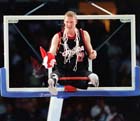|
 Athletes
with a different kind and level of disability
are competing at the Paralympic Games. In order
to compete on equal terms, athletes are
classified into different classes. Specialized
medical and technical personnel, called
classifiers, perform classification assessment.
They are evaluating the athletes with various
procedures and tests based on their functional
ability to perform skills required by the sport.
In that way it is guaranteed that the athletes
competing within a class have equal or similar
functional abilities and the determining factor
for their success is skill and training, rather
than the level of disability. Athletes
with a different kind and level of disability
are competing at the Paralympic Games. In order
to compete on equal terms, athletes are
classified into different classes. Specialized
medical and technical personnel, called
classifiers, perform classification assessment.
They are evaluating the athletes with various
procedures and tests based on their functional
ability to perform skills required by the sport.
In that way it is guaranteed that the athletes
competing within a class have equal or similar
functional abilities and the determining factor
for their success is skill and training, rather
than the level of disability.
Presently in most sports the functional
classification system is used. Functional
Classification means that all athletes in the
same class have similar levels of function in
areas as range motion, coordination and balance.
According to that system, athletes with
different kind of disabilities can compete
against each other if they have similar levels
of function.
 A
similar procedure is used in some Olympic sports
as well, with the use of weight categories.
Athletes are divided into categories according
to their weight. As a result a middleweight
boxer is not put in the ring with a heavyweight
boxer. A
similar procedure is used in some Olympic sports
as well, with the use of weight categories.
Athletes are divided into categories according
to their weight. As a result a middleweight
boxer is not put in the ring with a heavyweight
boxer.
The
classes are described by a letter, usually the
initial letter of the sport, and a number (e.g.
S5 in swimming, T44 in athletics - track). The
lower number usually represents a higher level
of disability.
Disability
categories
The athletes participating in the
Paralympic Games are included in the following
categories:
 |
Athletes
with Physical Disabilities |
| - |
Amputee
Athletes |
| - |
Athletes
with Spinal Cord Injuries |
| - |
Athletes
with Cerebral Palsy |
| - |
Les
Autres, i.e. athletes with a physical
disability that are not included in the
above-mentioned categories (e.g.
Muscular dystrophy) |
|
|
 |
Athletes
with Vision Impairments |
|
 Athletes
with a different kind and level of disability
are competing at the Paralympic Games. In order
to compete on equal terms, athletes are
classified into different classes. Specialized
medical and technical personnel, called
classifiers, perform classification assessment.
They are evaluating the athletes with various
procedures and tests based on their functional
ability to perform skills required by the sport.
In that way it is guaranteed that the athletes
competing within a class have equal or similar
functional abilities and the determining factor
for their success is skill and training, rather
than the level of disability.
Athletes
with a different kind and level of disability
are competing at the Paralympic Games. In order
to compete on equal terms, athletes are
classified into different classes. Specialized
medical and technical personnel, called
classifiers, perform classification assessment.
They are evaluating the athletes with various
procedures and tests based on their functional
ability to perform skills required by the sport.
In that way it is guaranteed that the athletes
competing within a class have equal or similar
functional abilities and the determining factor
for their success is skill and training, rather
than the level of disability. A
similar procedure is used in some Olympic sports
as well, with the use of weight categories.
Athletes are divided into categories according
to their weight. As a result a middleweight
boxer is not put in the ring with a heavyweight
boxer.
A
similar procedure is used in some Olympic sports
as well, with the use of weight categories.
Athletes are divided into categories according
to their weight. As a result a middleweight
boxer is not put in the ring with a heavyweight
boxer.